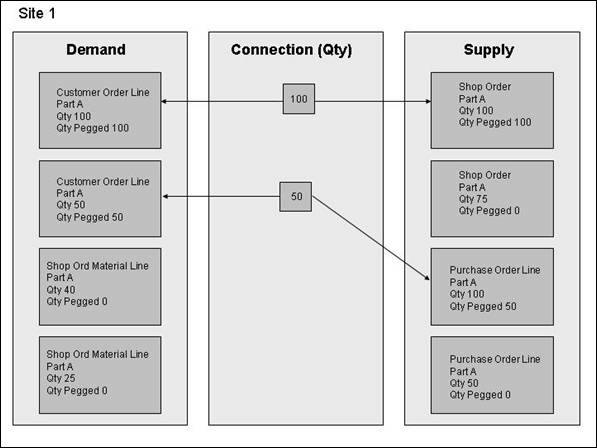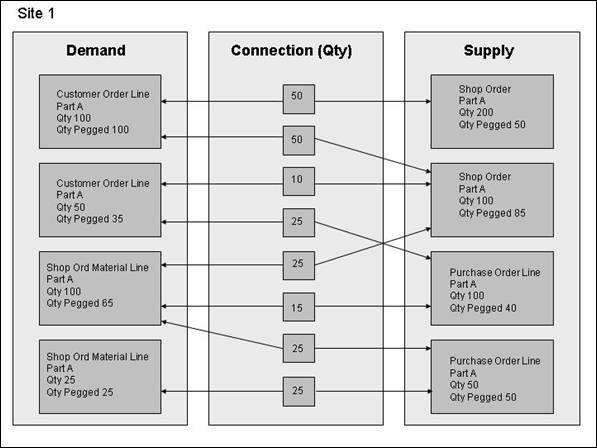Supply Pegging
Pegging is creating a connection between demands and supplies. Pegging can be created manually, or they can be created automatically ( e.g., by using supply code purchase order transit on the customer order).
The purpose of this document is to provide a brief introduction to pegging, and then to focus on the Manual Supply Pegging features in IFS Cloud.
Automatic Pegging
Automatic pegging is available in customer order, e.g., by using supply code purchase order transit. Creating and releasing a customer order line, using the supply code purchase order transit, will automatically create a purchase order line that upon receipt will be automatically allocated to the customer order line. The connection is a one to one connection between the CO line and the PO line.

Figure 1. Automatically Created Pegging
Figure 1 portrays one-to-one pegging between a customer order
line and the supply (either a purchase order line or a shop order). In Figure
1, the first order has supply code Shop Order and the second order has supply
code Purchase Order Transit.
Manual Pegging
Manual pegging is a method for manually connecting an existing supply to an existing demand. When this connection is made, it ensures that supplies are automatically allocated to the pegged demands whenever those supplies are received into inventory. The pegging is then replaced by a corresponding reservation.
Manual pegging is used in cases where you want to override the normal system behavior and enforce a strict connection between a supply and demand. (A normal supply, as opposed to a pegged supply, is free and available for manual or automatic allocation by any demand.)
Pegging of a CO demand can be seen as a pre-reservation of an incoming supply, thus this activity is performed prior to reservation.
Manual pegging in a general sense is key functionality to support resolution of supply problems in a shortage situation. By using manual pegging the user may, after having been notified that there is a supply problem for a part, create a supply, and connect the demand to the supply. The connection will ensure that the supply in question will be available for use only by the connected demand. Supply pegging is interesting not only in shortage situations, for example in the MRO industry it is often crucial to find the most suitable material supply for a shop order material line.
It is possible to peg;
- Customer order lines (demand) towards purchase order lines (supply) and shop orders (supply) depending on if the part is purchased or manufactured.
- Material requirements for shop order (demand) towards purchase order lines (purchased supply) and shop orders (manufactured supply).
- One demand line may be pegged to one or many supply lines.
- Many demand lines may be pegged to one supply line.
- A demand line for 100 pieces may be pegged against supply lines for 50+50 pieces.
- Demand lines for 25+25 pieces may be pegged against a supply line for 50 pieces.
- A demand line for 10 pieces may be pegged against a supply line for 25 pieces. Only 10 of the supply line quantity is pegged, while the remaining quantity is free.

Figure 2. Manually Created Pegging
Figure 2 portrays many-to-many pegging, and the complexities that may arise.
Note:
- Automatic and manual pegging cannot exist for the same supply or demand.
- Only supplies with the supply code set to Inventory Order can be manually pegged.
- Only demands with the supply code set to Inventory Order can be manually pegged.
- The scrap factor on the inventory part is not taken into consideration.
- The demands with the supply code set to either Project Inventory, Project or Non-inventory cannot be manually pegged. (Automatic reservations for though, are possible for parts in project inventory).
Once pegging is created, they may also be modified. As soon as a receipt is made (purchase order or shop order), the pegging is replaced by a corresponding reservation.